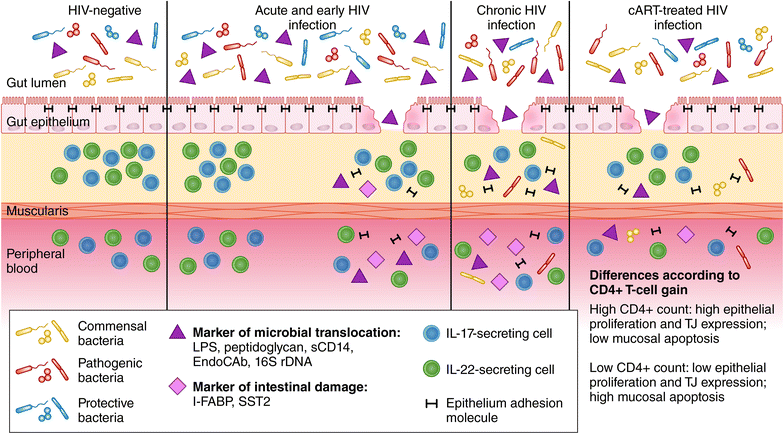Gut barrier structure, mucosal immunity and intestinal microbiota in the pathogenesis and treatment of HIV infection
- PMID: 27073405
- PMCID: PMC4828806
- DOI: 10.1186/s12981-016-0103-1
Gut barrier structure, mucosal immunity and intestinal microbiota in the pathogenesis and treatment of HIV infection
Abstract
Over the past 10 years, extensive work has been carried out in the field of microbial translocation in HIV infection, ranging from studies on its clinical significance to investigations on its pathogenic features. In the present work, we review the most recent findings on this phenomenon, focusing on the predictive role of microbial translocation in HIV-related morbidity and mortality, the mechanisms by which it arises and potential therapeutic approaches. From a clinical perspective, current work has shown that markers of microbial translocation may be useful in predicting clinical events in untreated HIV infection, while conflicting data exist on their role in cART-experienced subjects, possibly due to the inclusion of extremely varied patient populations in cohort studies. Results from studies addressing the pathogenesis of microbial translocation have improved our knowledge of the damage of the gastrointestinal epithelial barrier occurring in HIV infection. However, the extent to which mucosal impairment translates directly to increased gastrointestinal permeability remains an open issue. In this respect, novel work has established a role for IL-17 and IL-22-secreting T cell populations in limiting microbial translocation and systemic T-cell activation/inflammation, thus representing a possible target of immune-therapeutic interventions shown to be promising in the animal model. Further, recent reports have not only confirmed the presence of a dysbiotic intestinal community in the course of HIV infection but have also shown that it may be linked to mucosal damage, microbial translocation and peripheral immune activation. Importantly, technical advances have also shed light on the metabolic activity of gut microbes, highlighting the need for novel therapeutic approaches to correct the function, as well as the composition, of the gastrointestinal microbiota.
Keywords: Gastrointestinal barrier; Microbial translocation; Microbiota; Mucosal immunity.
Figures

References
-
- Liu Z, Hultin LE, Cumberland WG, et al. Elevated relative fluorescence intensity of CD38 antigen expression on CD8 + T cells is a marker of poor prognosis in HIV infection: results of 6 years of follow-up. Cytometry. 1996;26:1–7. doi: 10.1002/(SICI)1097-0320(19960315)26:1<1::AID-CYTO1>3.0.CO;2-L. - DOI - PubMed
-
- Giorgi JV, Hultin LE, McKeating JA, et al. Shorter survival in advanced human immunodeficiency virus type 1 infection is more closely associated with T lymphocyte activation than with plasma virus burden or virus chemokine coreceptor usage. J Infect Dis. 1999;179:859–870. doi: 10.1086/314660. - DOI - PubMed
Publication types
MeSH terms
LinkOut - more resources
Full Text Sources
Other Literature Sources
Medical
Miscellaneous

